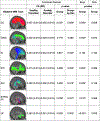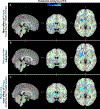Sex-Specific Distributed White Matter Microarchitectural Alterations in Preadolescent Youths With Anxiety Disorders: A Mega-Analytic Study
- PMID: 38476042
- PMCID: PMC11129321
- DOI: 10.1176/appi.ajp.20221048
Sex-Specific Distributed White Matter Microarchitectural Alterations in Preadolescent Youths With Anxiety Disorders: A Mega-Analytic Study
Abstract
Objective: Anxiety disorders are among the most common psychiatric disorders in youths and emerge during childhood. This is also a period of rapid white matter (WM) development, which is critical for efficient neuronal communication. Previous work in preadolescent children with anxiety disorders demonstrated anxiety disorder-related reductions in WM microstructural integrity (fractional anisotropy [FA]) in the uncinate fasciculus (UF), the major WM tract facilitating prefrontal cortical-limbic structural connectivity. Importantly, this association was found only in boys with anxiety disorders. To confirm this finding and more comprehensively understand WM changes in childhood anxiety, this mega-analytic study characterizes WM alterations related to anxiety disorders and sex in the largest sample of preadolescent children to date.
Methods: Diffusion tensor imaging data from published studies of preadolescent children with anxiety disorders and healthy volunteers (ages 8-12) (N=198) were combined with a new data set (N=97) for a total sample of 165 children with anxiety disorders and 132 healthy volunteers. Children with anxiety disorders met DSM-5 criteria for current generalized, separation, and/or social anxiety disorder. Analyses of tractography and voxel-wise data assessed between-group differences (anxiety disorder vs. healthy volunteer), effects of sex, and their interaction.
Results: Tract-based and voxel-wise analyses confirmed a significant reduction in UF FA in boys but not girls with anxiety disorders. Results also demonstrated other significant widespread anxiety disorder-related WM alterations specifically in boys, including in multiple commissural, association, projection, and brainstem regions.
Conclusions: In addition to confirming male-specific anxiety disorder-related reductions in UF FA, the results demonstrate that anxiety disorders in boys and not girls are associated with broadly distributed WM alterations across the brain. These findings support further studies focused on understanding the extent to which WM alterations in boys with anxiety disorders are involved in pathophysiological processes that mediate anxiety disorders. The findings also suggest the possibility that WM microarchitecture could serve as a novel treatment target for childhood anxiety disorders.
Keywords: Anxiety Disorders; Child/Adolescent Psychiatry; Gender Differences; Neuroimaging.
Figures



Similar articles
-
Altered Uncinate Fasciculus Microstructure in Childhood Anxiety Disorders in Boys But Not Girls.Am J Psychiatry. 2019 Mar 1;176(3):208-216. doi: 10.1176/appi.ajp.2018.18040425. Epub 2019 Jan 18. Am J Psychiatry. 2019. PMID: 30654645 Free PMC article.
-
A dynamic relation between whole-brain white matter microstructural integrity and anxiety symptoms in preadolescent females with pathological anxiety.Transl Psychiatry. 2022 Feb 8;12(1):57. doi: 10.1038/s41398-022-01827-y. Transl Psychiatry. 2022. PMID: 35136030 Free PMC article.
-
Shared and distinctive changes of the white matter integrity in generalized anxiety disorder with or without depressive disorder.J Psychiatr Res. 2025 Feb;182:430-437. doi: 10.1016/j.jpsychires.2025.01.047. Epub 2025 Jan 24. J Psychiatr Res. 2025. PMID: 39889404
-
White Matter-Based Structural Brain Network of Anxiety.Adv Exp Med Biol. 2020;1191:61-70. doi: 10.1007/978-981-32-9705-0_4. Adv Exp Med Biol. 2020. PMID: 32002922 Review.
-
Regional differences in white matter integrity in stimulant use disorders: A meta-analysis of diffusion tensor imaging studies.Drug Alcohol Depend. 2019 Aug 1;201:29-37. doi: 10.1016/j.drugalcdep.2019.03.023. Epub 2019 May 29. Drug Alcohol Depend. 2019. PMID: 31176066 Free PMC article.
Cited by
-
Neural Markers of Treatment Response in Pediatric Anxiety and PTSD.Curr Top Behav Neurosci. 2024 Dec 14:10.1007/7854_2024_547. doi: 10.1007/7854_2024_547. Online ahead of print. Curr Top Behav Neurosci. 2024. PMID: 39673034
-
Structure-function coupling in network connectivity and associations with negative affectivity in a group of transdiagnostic adolescents.J Mood Anxiety Disord. 2025 Mar;9:100094. doi: 10.1016/j.xjmad.2024.100094. Epub 2024 Nov 20. J Mood Anxiety Disord. 2025. PMID: 39758557 Free PMC article.
References
-
- Kessler RC, Berglund P, Demler O, Jin R, Merikangas KR, Walters EE. Lifetime Prevalence and Age-of-Onset Distributions of DSM-IV Disorders in the National Comorbidity Survey Replication. Arch Gen Psychiat. 2005;62(6):593–602. - PubMed
-
- Bittner A, Egger HL, Erkanli A, Costello EJ, Foley DL, Angold A. What do childhood anxiety disorders predict? J Child Psychol Psyc. 2007;48(12):1174–83. - PubMed
MeSH terms
Grants and funding
LinkOut - more resources
Full Text Sources
Miscellaneous

